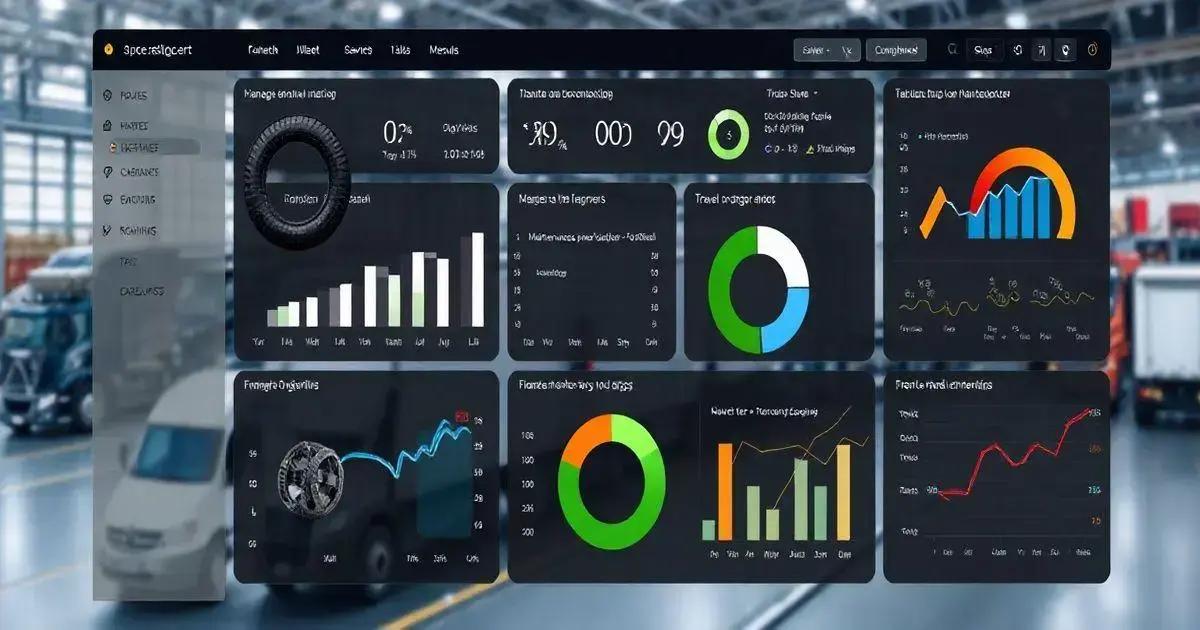Maximize Efficiency with Fleet Control Worksheet 7.0 Leave a comment
The Fleet Control Worksheet 7.0 is a vital tool for fleet management, offering features like an intuitive dashboard for tracking key metrics such as kilometers driven, fuel efficiency, and maintenance costs. It includes travel and cargo management tools, tire management strategies, and a maintenance control section that balances preventive and corrective maintenance, ultimately helping fleet managers optimize operations and maintain a cost-effective fleet.
Are you looking to enhance your fleet management? The Fleet Control Worksheet 7.0 offers an intuitive solution to keep your operations running smoothly.
This worksheet features an initial dashboard, travel and cargo control, tire management, and both preventive and corrective maintenance tracking.
In this article, we’ll dive deep into its functionalities and how it can optimize your fleet operations.
Key Features of Fleet Control Worksheet 7.0
The Fleet Control Worksheet 7.0 is designed with features that cater to your fleet management needs effectively. Here’s a closer look at what it offers:
Key Features of Fleet Control Worksheet 7.0
- Comprehensive Dashboard: The initial dashboard provides an at-a-glance view of essential metrics, including KM per driver, average fuel consumption, and total maintenance costs.
- Travel and Cargo Tracking: Easily manage your travel logistics with integrated controls that link cargo directly to trips, ensuring accurate tracking of vehicle usage and deliveries.
- Tire Management: Features a tire change schedule based on KM traveled, helping you keep track of tire health and optimize replacement timings.
- Maintenance Control: The worksheet differentiates between preventive and corrective maintenance, allowing you to plan maintenance schedules and track service history effectively, ensuring your fleet is always in peak condition.
- Document Management: It includes controls for managing driver and vehicle documents, helping you stay compliant with regulations and maintaining necessary documentation on hand.
These features work synergistically to enhance your fleet’s operational efficiency, reduce maintenance costs, and improve overall management, making the Fleet Control Worksheet 7.0 a vital tool for fleet managers.

Initial Dashboard Overview
The Initial Dashboard of the Fleet Control Worksheet 7.0 is a powerful tool that brings together critical fleet metrics into one user-friendly interface. This dashboard is designed to provide fleet managers with immediate insights into their operations, making it easier to make data-driven decisions.
Key Metrics: The dashboard prominently displays key performance indicators such as:
- KMs Driven per Driver: Track the distance each driver covers, helping you evaluate performance and efficiency.
- KMs per Vehicle: Monitor total distance driven by each vehicle, aiding in maintenance scheduling and fuel management.
- Fuel Efficiency: Analyze average consumption per vehicle and driver, allowing you to identify trends and optimize fuel usage.
Maintenance Overview: See a summary of all maintenance activities, including:
- Total Preventive and Corrective Costs: Evaluate how much you’re spending on vehicle upkeep, enabling you to budget more effectively.
- Average Maintenance Costs: Gain insight into your average spending on vehicle maintenance, helping you make informed decisions regarding repairs and replacements.
Alerts and Notifications: The dashboard can flag important alerts, such as:
- Upcoming preventive maintenance schedules.
- Documents that are nearing expiration, ensuring compliance.
- Vehicles that require immediate attention due to issues reported.
This overview not only simplifies the management process but also equips fleet managers with the tools they need to enhance productivity, reduce costs, and maintain a reliable fleet.
Travel and Cargo Management Tools
The Travel and Cargo Management Tools within the Fleet Control Worksheet 7.0 are designed to streamline and enhance the efficiency of your logistics operations. These tools allow fleet managers to maintain control over travel details and cargo handling, ensuring that every aspect of transportation is meticulously recorded and analyzed.
Travel and Cargo Management Tools
- Cargo Control Integration: This feature links cargo directly to trips, allowing you to track:
- Load Details: Keep comprehensive records of what cargo is being transported, including weight, quantity, and type, which aids in compliance and billing.
- Delivery Timelines: Monitor each cargo’s delivery status, ensuring timely arrivals and enhancing customer satisfaction.
- Vehicle Control: The tools provide a clear overview of:
- Vehicle Allocation: Assign specific vehicles to trips based on availability, capacity, and driver assignments.
- Trip Logs: Maintain detailed logs of each trip, including departure and arrival times, routes taken, and any deviations from planned schedules.
- Expense Tracking: This feature facilitates tracking all travel expenses, such as:
- Fuel Costs: Record fuel purchases during each trip, allowing for a better understanding of fuel efficiency and budgeting.
- Toll and Miscellaneous Fees: Easily account for all additional costs incurred during travel, ensuring accurate financial planning.
- Reporting Capabilities: Generate reports on:
- Cargo Efficiency: Analyze how effectively cargo space is utilized across different trips.
- Travel Performance: Evaluate driver performance, vehicle efficiency, and overall travel costs to identify areas for improvement.
By utilizing these tools, fleet managers can ensure that cargo is handled efficiently, travel expenses are monitored, and records are meticulously maintained, thus leading to improved operational efficiency and reduced costs.

Tire Management Strategies
Effective tire management is crucial for maintaining the safety, efficiency, and cost-effectiveness of a fleet. The Tire Management Strategies in the Fleet Control Worksheet 7.0 are designed to help fleet managers implement a systematic approach to tire care, monitoring, and replacement.
Tire Management Strategies
- Tire Identification: Each tire can be assigned a unique identification number, allowing for easy tracking of:
- Service History: Document all maintenance performed on each tire, including rotations, repairs, and replacements.
- Wear Patterns: Analyze tire wear to identify issues such as misalignment or improper inflation, which can lead to premature wear.
- Tire Change Schedule: This feature generates a tire change schedule based on:
- Kilometers Traveled: Set thresholds for when tires should be inspected or replaced based on the distance they have covered.
- Time Intervals: Establish time-based maintenance intervals to ensure tires are regularly checked, regardless of mileage.
- Monitoring Remaining Tread Depth: The worksheet provides tools to log the remaining tread depth of each tire, helping to manage:
- Replacement Planning: Identify tires that need to be replaced in advance, preventing unexpected downtime.
- Safety Compliance: Ensure that all tires meet legal safety standards, reducing the risk of accidents caused by worn-out tires.
- Status Per Action: Manage the status of each tire through a comprehensive tracking system that includes:
- Allocation to Vehicles: Monitor which tires are allocated to which vehicles, ensuring all vehicles are equipped with appropriately maintained tires.
- Maintenance Actions: Keep track of actions needed, such as rotating tires or performing repairs, to optimize tire longevity.
Utilizing these tire management strategies not only extends the lifespan of tires, enhancing safety and performance, but also reduces overall fleet operating costs through improved fuel efficiency and fewer replacements.
Maintenance Control: Preventive vs. Corrective
In the realm of fleet management, understanding the distinction between preventive and corrective maintenance is essential for optimizing vehicle uptime and reducing costs. The Fleet Control Worksheet 7.0 incorporates robust tools for managing both types of maintenance effectively.
Maintenance Control: Preventive vs. Corrective
- Preventive Maintenance: This proactive approach focuses on regularly scheduled services to prevent potential issues before they occur. Key features include:
- Scheduled Service Reminders: The worksheet sends alerts for scheduled checks based on mileage or time intervals, such as oil changes, tire rotations, or general inspections.
- Maintenance Histories: Keep detailed records of all preventive services performed on each vehicle, enabling you to track compliance and service quality.
- Cost Analysis: Analyze spending on preventive maintenance over time, helping to justify budgets and ensure resources are allocated efficiently.
- Corrective Maintenance: This reactive approach addresses issues after they arise. The worksheet provides tools to:
- Document Repairs: Record corrective actions taken for each vehicle, including repairs and replacements, to maintain comprehensive maintenance logs.
- Track Downtime: Monitor how long each vehicle is out of service due to corrective actions, allowing for better resource planning and scheduling.
- Cost Tracking: Analyze corrective maintenance costs to identify patterns that may indicate persistent issues with specific vehicles, helping to inform future preventive measures.
- Balancing Preventive and Corrective Maintenance: The worksheet helps managers evaluate the effectiveness of both maintenance strategies by:
- Comparing Costs: Easily compare costs associated with preventive versus corrective maintenance, allowing for informed decision-making.
- Monitoring Vehicle Performance: Assess how well vehicles perform under each maintenance strategy to determine the right balance for your fleet.
By leveraging the tools in the Fleet Control Worksheet 7.0, fleet managers can ensure they adopt a balanced approach to maintenance that maximizes vehicle availability, minimizes costs, and enhances overall operational efficiency.
Conclusion
In summary, the Fleet Control Worksheet 7.0 is an indispensable tool for fleet managers aiming to optimize operations.
With its comprehensive features, including the initial dashboard, travel and cargo management tools, tire management strategies, and robust maintenance control, this worksheet facilitates effective monitoring and management of fleet activities.
By implementing both preventive and corrective maintenance strategies, users can enhance vehicle performance, reduce downtime, and significantly lower operating costs.
Ultimately, the insights and organization provided by the Fleet Control Worksheet 7.0 empower fleet managers to make informed decisions that will drive efficiency and improve the overall success of fleet operations.
Start using the Fleet Control Worksheet 7.0 today to streamline your fleet management and ensure your vehicles are always performing at their best!
FAQ – Frequently Asked Questions about Fleet Control Worksheet 7.0
What features does the Fleet Control Worksheet 7.0 offer?
The Fleet Control Worksheet 7.0 offers features such as an initial dashboard for key metrics, travel and cargo management tools, tire management strategies, and maintenance control for both preventive and corrective actions.
How can I track tire maintenance using the worksheet?
You can track tire maintenance by logging tire identification numbers, documenting service history, monitoring tread depth, and creating a tire change schedule based on kilometers traveled.
What is the difference between preventive and corrective maintenance?
Preventive maintenance involves scheduled services to prevent issues before they occur, while corrective maintenance addresses repairs after a problem has been detected.
Can I analyze costs associated with maintenance?
Yes, the worksheet allows you to analyze both preventive and corrective maintenance costs, helping you to identify trends and justify budgets.
Is the Fleet Control Worksheet 7.0 compatible with various versions of Excel?
Yes, it works on all versions of Excel, including 2007, 2010, 2013, and 2016, and is compatible with Windows operating systems.
How do I get support if I face issues with the worksheet?
Support is available free of charge from Monday to Friday, from 9 am to 4 pm, either via email or WhatsApp for any inconsistencies or execution problems.

